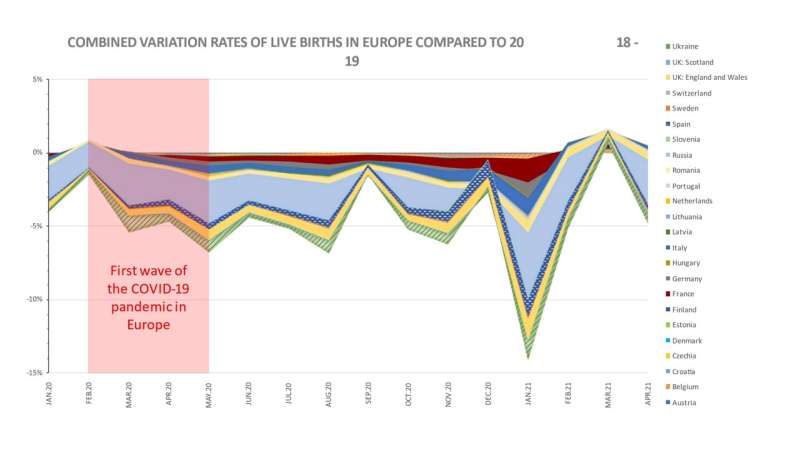clindamycin capsule prospect


Europe saw a 14% decrease in live births in January 2021, just nine to ten months after the first peak of the COVID-19 epidemic and the first lockdowns, compared to the average numbers of live births in January 2018 and 2019.
The researchers of the study, which is published in Human Reproduction, say that the decrease may be associated with the lockdowns imposed in many European countries rather than to people becoming infected with COVID-19 and encountering problems as a result of infection, such as deaths, miscarriages or still births. For this to be the case, erythromycin cystitis dosage there would have been a drop in live births just a few weeks or months after exposure to COVID-19, which they did not observe
First author of the study Dr. Léo Pomar, a midwife sonographer at Lausanne University Hospital and associate professor at the School of Health Sciences in Lausanne, Switzerland, said, “The decline in births nine months after the start of the pandemic appears to be more common in countries where health systems were struggling and capacity in hospitals was exceeded. This led to lockdowns and social distancing measures to try to contain the pandemic.
“The longer the lockdowns, the fewer pregnancies occurred in this period, even in countries not severely affected by the pandemic. We think that couples’ fears of a health and social crisis at the time of the first wave of COVID-19 contributed to the decrease in live births nine months later.”
Previous pandemics in the 20th and 21st centuries, such as the 1918 Spanish flu pandemic and the 2013 Ebola and 2016 Zika virus outbreaks, were also associated with a decline in birth rates nine months after their peaks. The reasons were the high death rates in parents for the first two pandemics and high fetal death rates as a result of direct exposure to Zika. The desire of couples to postpone pregnancy in a time of crisis also played a role. The researchers of the current study wondered whether a similar trend would be seen after the COVID-19 pandemic.
They looked at data from 24 European countries for the periods immediately before and after the first wave of the COVID-19 pandemic. They adjusted the live birth rates to take account of seasonal variations and found that January 2021 was the only month in which there was a significant drop in live births.
At the national level, decreases in birth rates in January 2021 were seen in Belgium (12% decrease), Estonia (13%), France (14%), Italy (17%), Latvia 15.5%), Lithuania (28%), Portugal (18%), Romania (23%), Russia (19%), Spain (23.5%), Ukraine (24%), England and Wales (13%), and Scotland (14%). Seven countries had intensive care units that were over-occupied (more than 100% full) and six of these (Belgium, France, Italy, Spain, England and Scotland) saw substantial drops in birth rates. The seventh country, Denmark, did not. Only two out of nine countries in which there was a slight or moderate impact on intensive care units experienced a decline in births nine months later.
March 2021 was the only month with a live birth rate similar to the pre-pandemic monthly rate, corresponding to a rebound nine to ten months after the end of lockdowns. However, the researchers say that this rebound does not seem to compensate for the decline in birth rates in January 2021.
Further analysis showed that the duration of lockdowns was the only factor linked to the drop in live births in January 2021 compared to January 2018 and January 2019. In addition, countries with a lower income per capita tended to have decreases in live births of more than 10% in January 2021. Sweden, which did not have a lockdown but did have a high number of deaths, did not have a drop in live births.
“The association we found with the duration of lockdowns may reflect a much more complex phenomenon, in that lockdowns are government decisions used as a last resort to contain a pandemic. Lockdown duration has a direct impact on couples,” said Dr. Pomar.
He said that the information from this study was important for health services and policy makers. “It is of particular importance for maternity services, which could adapt staffing levels to birth patterns after pandemics: Fewer pregnancies are expected at the time of pandemics, but a rebound in pregnancies could be observed after the end of them. The fact that the rebound in births does not seem to compensate for the decrease in January 2021 could have long-term consequences on demographics, particularly in western Europe where there are aging populations.”
Dr. Pomar and his colleagues plan to see if there are similar trends after the subsequent waves of the pandemic and lockdowns. “Over time, the pandemic becomes endemic, its consequences during pregnancy are better known, vaccination is available, and it is possible that this decline in births has been mitigated in subsequent waves,” he said.
Limitations of the study are that it was based on national data, which might limit the ability to identify other potential factors contributing to a decrease or increase in live births, and the researchers collected data only up to April 2021, which makes it impossible to identify seasonal differences in birth for 2021.
Professor Christian De Geyter, of the University of Basel, Switzerland, was not involved in the research and is a deputy editor of the journal Human Reproduction. In a commentary accompanying the paper, he writes, “These observations are important because they show that human reproductive behavior, as evidenced by numbers of live births, changes during dramatic events, epidemics and global crises… Fewer live births will result in more rapidly aging populations and in lesser economic growth.
Source: Read Full Article